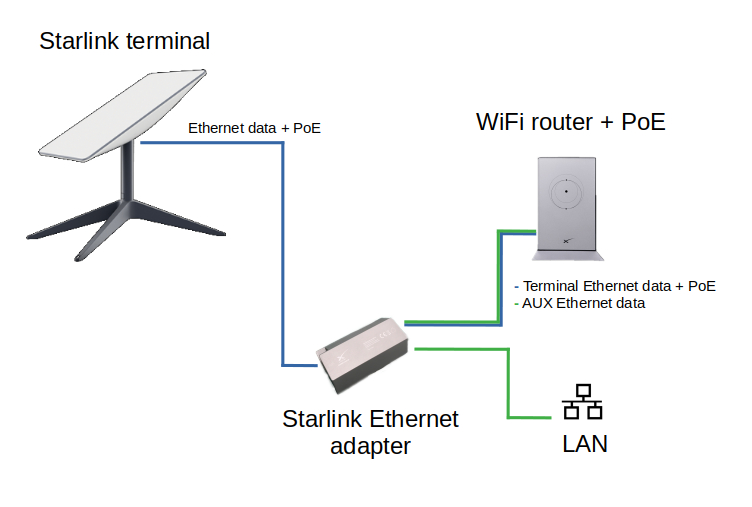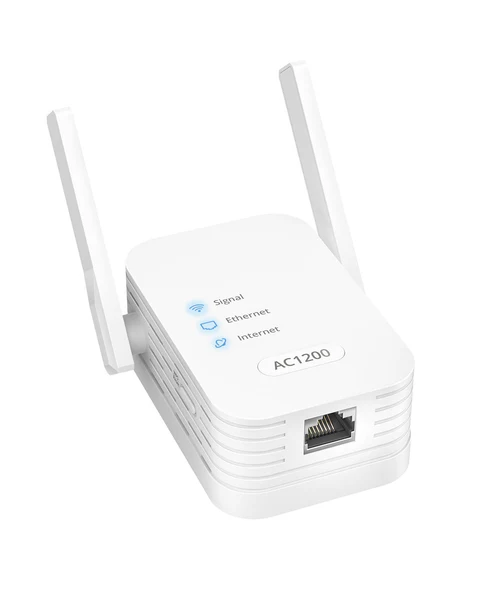No products in the cart.

Starlink, the revolutionary satellite internet service provided by SpaceX, has been a game-changer for many users, particularly in areas with limited or no access to traditional broadband internet.
However, one aspect that has been a point of discussion among Starlink users is the proprietary Starlink Ethernet adapter, which is required to connect the Starlink dish to a router or directly to devices.
While the official Starlink Ethernet adapter works seamlessly with the system, some users have expressed interest in exploring alternative options, either due to cost considerations, availability issues, or personal preferences.
In this article, we’ll delve into the world of Starlink Ethernet adapter alternatives, examining their viability, compatibility, and potential benefits.
How Starlink Ethernet Adapter Works

Before we explore the alternatives, it’s essential to understand the role of the Starlink Ethernet adapter and its significance in the overall Starlink setup.
The Starlink Ethernet adapter is a specialized device designed to convert the proprietary Starlink network protocol into standard Ethernet, enabling seamless connectivity between the Starlink dish and your router or devices.
The official Starlink Ethernet adapter is pre-configured and optimized to work flawlessly with the Starlink system, ensuring a smooth and reliable internet experience.
However, it comes at an additional cost, which some users may find prohibitive, especially if they already have an existing Ethernet adapter or router capable of handling the necessary network protocols.
Here Are Starlink Ethernet Adapter Alternatives
While the official Starlink Ethernet adapter is the recommended option for ensuring optimal performance and compatibility, some users have explored alternative solutions to connect their Starlink dish to their home network. These alternatives range from repurposing existing networking equipment to third-party adapters designed specifically for Starlink.
1. Repurposing Existing Networking Equipment
One potential Starlink Ethernet adapter alternative is to repurpose existing networking equipment that you may already have at home. This approach can be cost-effective, as it eliminates the need to purchase additional hardware.
However, it’s crucial to ensure that your existing equipment is compatible with the Starlink network protocol and can handle the necessary data rates and network configurations.
Some users have reported success in using certain routers or network switches with advanced firmware, such as OpenWrt or DD-WRT, to connect their Starlink dish directly to their home network.
This approach requires a certain level of technical expertise and may involve configuring the firmware and network settings to ensure proper functionality.
2. Third-Party Adapters
Another option for Starlink Ethernet adapter alternatives is to explore third-party adapters designed specifically for Starlink. These adapters are typically developed by independent manufacturers or enthusiast communities and aim to provide a more affordable or feature-rich alternative to the official Starlink Ethernet adapter.
One example of a third-party adapter is the Ubiquiti Ethernet Rocket, which has been reported to work with Starlink in certain configurations. This adapter is designed for outdoor wireless networking but has been successfully adapted by some users to connect their Starlink dish to their home network.
While these third-party adapters may work, they are not officially supported or endorsed by Starlink, and their compatibility and performance may vary. Users who choose to go this route should be prepared to troubleshoot and potentially encounter compatibility issues or limitations.
Another option is Bros Trend AC1200 WIFI to Ethernet Adapter.

The BrosTrend AC1200 WIFI to Ethernet Adapter can be a good alternative to the official Starlink Ethernet Adapter, especially if you are looking for a budget-friendly and versatile solution.
Pros:
- Affordability: It is often significantly cheaper than the official Starlink Ethernet Adapter.
- Dual-Band Support: It supports both 2.4GHz and 5GHz Wi-Fi bands, offering flexibility and potentially faster speeds.
- Easy Setup: It typically features a WPS button for quick and easy connection to your Starlink router.
- Wide Compatibility: It works with various Ethernet-enabled devices like smart TVs, gaming consoles, printers, and more.
- Compact Design: Its small size makes it easy to place and doesn’t clutter your setup.
- Cons:
- Potential Speed Limitations: Its maximum theoretical speed is 1200Mbps, which may be lower than some high-end powerline or MoCA adapters.
- Reliance on Wi-Fi Signal Strength: Its performance depends on the strength and stability of your Starlink’s Wi-Fi signal.
- Additional Power Outlet Required: It needs to be plugged into a power outlet, which might be inconvenient in some setups.
3. DIY Solutions
For those with a more adventurous spirit and technical know-how, there are also DIY (Do-It-Yourself) solutions for Starlink Ethernet adapter alternatives.
These solutions typically involve repurposing readily available hardware components, such as single-board computers (e.g., Raspberry Pi) or network adapters, and configuring them to work with the Starlink network protocol.
One popular DIY solution involves using a Raspberry Pi with specialized software or firmware to act as a bridge between the Starlink dish and your home network.
This approach requires a certain level of technical expertise and may involve compiling custom software or firmware, as well as configuring network settings and protocols.
While DIY solutions can be cost-effective and provide a sense of accomplishment, they also come with inherent risks and potential compatibility issues.
Users who choose to pursue DIY Starlink Ethernet adapter alternatives should be prepared to invest significant time and effort into research, troubleshooting, and ongoing maintenance.
Considerations and Potential Drawbacks
While exploring Starlink Ethernet adapter alternatives can be appealing for various reasons, it’s essential to consider the potential drawbacks and limitations associated with these alternatives:
- Compatibility Issues: Alternative adapters or DIY solutions may not be fully compatible with the Starlink network protocol or may require specific configurations or firmware versions to work correctly. This can lead to connectivity issues, performance degradation, or even complete failure to connect.
- Lack of Official Support: Since these alternatives are not officially supported by Starlink, users may encounter difficulties in obtaining technical support or troubleshooting assistance from the Starlink team.
- Performance Limitations: While some alternative adapters or DIY solutions may work, they may not provide the same level of performance or reliability as the official Starlink Ethernet adapter, which is optimized and designed specifically for the Starlink system.
- Security Concerns: Using third-party or DIY solutions may introduce potential security vulnerabilities or expose your network to risks, as these solutions may not have undergone the same rigorous testing and security audits as the official Starlink hardware.
- Compatibility with Future Updates: As Starlink continues to evolve and introduce new features or updates, alternative adapters or DIY solutions may become incompatible or require significant modifications to maintain functionality.
It’s essential to weigh the potential benefits of using Starlink Ethernet adapter alternatives against these considerations and determine whether the trade-offs are acceptable for your specific use case.
Making an Informed Decision
When it comes to choosing a Starlink Ethernet adapter alternative, there is no one-size-fits-all solution. Each user’s needs, technical expertise, and risk tolerance will play a significant role in determining the most appropriate option.
Here are some factors to consider when making an informed decision:
- Cost: Evaluate the cost savings of using an alternative adapter compared to the official Starlink Ethernet adapter, factoring in any additional hardware or software required.
- Technical Expertise: Assess your level of technical expertise and willingness to troubleshoot and maintain alternative solutions, as they may require more hands-on configuration and maintenance.
- Performance Requirements: Consider your internet usage patterns and bandwidth requirements to determine if alternative adapters can provide the necessary performance and reliability.
- Compatibility with Existing Network: Ensure that any alternative adapter or DIY solution is compatible with your existing home network infrastructure, including routers, switches, and other networking equipment.
- Future-Proofing: Consider the potential impact of future Starlink updates or changes on the compatibility and functionality of alternative adapters or DIY solutions.
Ultimately, the decision to explore Starlink Ethernet adapter alternatives should be based on a careful evaluation of your specific needs, priorities, and risk tolerance. For some users, the official Starlink Ethernet adapter may remain the most reliable and straightforward option, while others may find alternative solutions more appealing based on their unique circumstances.
Conclusion
The availability of Starlink Ethernet adapter alternatives provides users with additional options and flexibility when it comes to connecting their Starlink dish to their home network. While these alternatives may offer cost savings or customization opportunities, it’s crucial to carefully evaluate their compatibility, performance, and potential drawbacks before making a decision.
Whether you choose to use the official Starlink Ethernet adapter or explore alternative solutions, the ultimate goal is to ensure a reliable and seamless internet experience with Starlink. As with any technology, staying informed, researching thoroughly, and making an informed decision based on your specific needs and requirements is essential.
Remember, the world of technology is constantly evolving, and new solutions or updates may emerge in the future, further expanding the options available for Starlink Ethernet adapter alternatives.
Read also:
